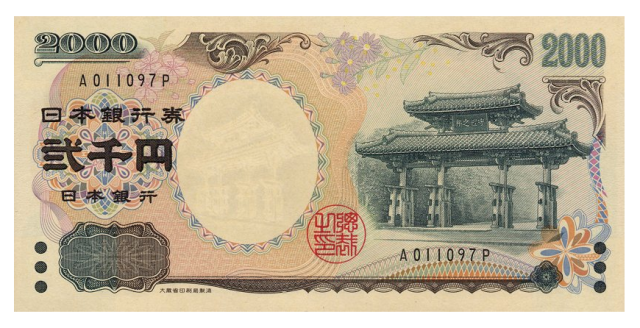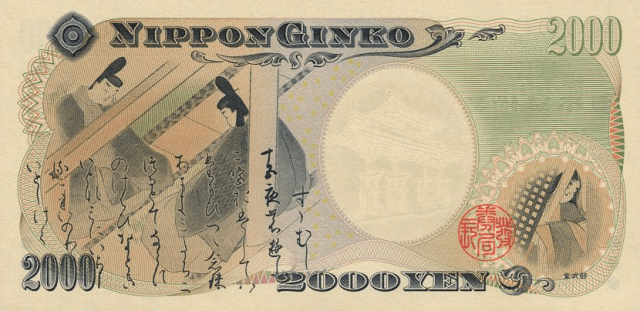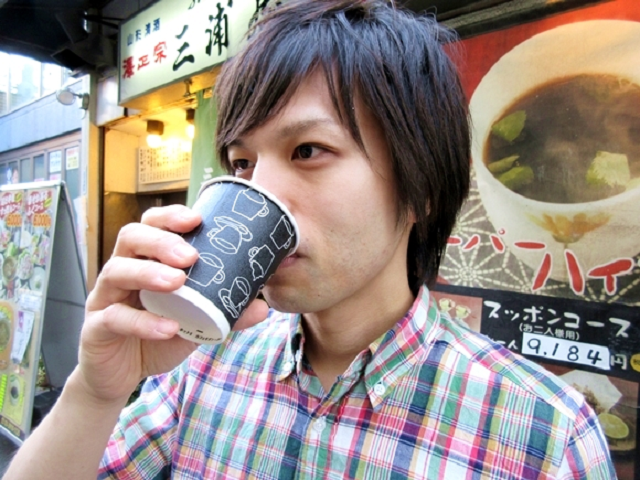
We interview Japan’s least-popular form of currency and the only bill not to be getting a slick new face-lift in the near future.
This week, Japan’s Ministery of Finance revealed its redesigns for the Japanese yen, with major cosmetic changes that will add beautiful ukiyo-e woodblock print art and one of Japan’s earliest pioneers of women’s education to country’s banknotes. However, while the 1,000, 5,000, and 10,000-yen bills are enjoying their moment in the spotlight, you’d be forgiven for not knowing Japan also has a 2,000-yen bill, even if you’ve traveled to the country multiple times.
Introduced in 2000, the little-seen bill features the Shureimon, one of the gates to Okinawa’s Shuri Castle, on its front, and a portrait of 10th-century writer Murasaki Shikibu, author of The Tale of Genji, on the back.
However, the Ministry of Finance was conspicuously silent about the 2,000-yen bill during the unveiling of the updated yen designs, and it’s since been confirmed that it will not be redesigned. In the beginning, the Japanese government had big plans for the 2,000-yen bill, the first new paper denomination to be created since 1958. Economists hoped their introduction would encourage more spending by consumers by helping to sidestep the psychological hurdle of having to break a 5,000-yen ($45) bill, which often has people deciding to forgo discretionary purchases instead.
Alas, the 2,000-yen bill has never really caught on (the exact reason why is unclear, but not being able to use them in most vending machines is assumed to be a major factor). Initially, the bank of Japan wanted to have one billion 2,000-yen bills out in the Japanese economy by the end of the year 2000, but so far peak circulation for the bill has been a meager 513 million in 2004. The number has fallen since then, dropping below 100 million since 2014, and the Bank of Japan is sitting on a large surplus of already-printed, yet-to-be-circulated 2,000-yen bills, prompting a spokesperson for the organization to tell reporters:
“Currently, there are large reserves of 2,000-yen bills at the Bank of Japan. In contrast to other bills, which are printed every year, no new 2,000-yen bills are being printed now. Redesigning the 2,000-yen bill would make the reserves obsolete, and so it was left out of the recent redesign.”
Some would call this an embarrassing turn of events for the youngest member of the family of Japanese banknotes, but to see how the 2,000-yen bill itself feels about the whole thing, we decided to go straight to the source, and using the interpretation skills of our reporter Ahiru Neko, interviewed a 2,000-yen bill he happened to have in his wallet.
▼ Ahiru Neko, whose previous forays into hard-hitting financial journalism have included testing whether being crapped on by a pigeon is a wise investment strategy and how much floor space 100,000 one-yen coins take up.
Ahiru Neko: 2,000-yen Bill-san, it’s been a long time. How many years has it been since we last saw each other?
2,000-yen Bill: It’s got to be at least a couple of years now, for sure.
Ahiru Neko: What have you been up to recently?
2,000-yen Bill: You know, just working, like usual. I’m actually pretty popular in Okinawa, you know. They even talk about how big I am there on my Wikipedia page.
Ahiru Neko: The bank of Japan announced redesigns for the yen bills, but, unfortunately, you were not included. How did you feel when you learned you’ve been left out of the project?
2,000-yen Bill: Well, to be honest, they didn’t even talk to me about the redesigns for the other bills ahead of time. I only found out about it from reading SoraNews24.
Ahiru Neko: I see.
2,000-yen Bill: To tell you the truth, my reaction was “Well, I guess that proves that I’m just not keeping up with the other bills in being productive and useful.” But you could also say that’s because I simply haven’t been given enough work to do. So I guess you could say it’s just sort of how things turned out, that I got left out of the redesign due to a variety of factors.
Ahiru Neko: Of course. Even now, on the rare occasion where I get a 2,000-yen bill as change, I find myself wondering “Can I use this in vending machines, or not?’”
2,000-yen Bill: Actually, recently there are some machines that let me in, but yeah, that problem has caused me a lot of mental anguish. Even in cash registers, they have slots set aside for the cashier to put 1,000, 5,000, and 10,000-yen bills in, right? They even make sure there are spots for the one and five-yen coins. But there’s never a place just for me. I have to cram my way into some slot for random bits or credit cards, and then no one notices me when they’re counting out change for the customer. Then at the end of the day, when they close up shop, I just get shipped off to the bank instead.
Ahiru Neko: But might that be because the shop staff are trying to let you down gently? You must hate that awkward confusion when a customer gets you as change.
2,000-yen Bill: Yeah, I guess so. After being treated like that for so long, it’s not really such a shock that I got left out of the redesign, but the next time I’m down in Okinawa, I think I’ll stop by Shureimon and have a good cry.
Ahiru Neko: Thank you for your time.
Like 2,000-yen Bill-san told us, it’s actually pretty popular in Okinawa, since it’s the only piece of Japanese currency on which the country’s southernmost prefecture is represented. As a matter of fact, it’s so well-loved there that you can actually specifically request 2,000-yen bills when you’re withdrawing money from certain ATMs in Okinawa, so consider showing it some love next if you’re ever there.
Related: Okinawa Times
Top image: Wikipedia/Gryffindor
Insert images: Wikipedia/Gryffindor. SoraNews24
● Want to hear about SoraNews24’s latest articles as soon as they’re published? Follow us on Facebook and Twitter!
[ Read in Japanese ]



 The Bank of Japan is really jazzed up about the new 10,000 yen bill
The Bank of Japan is really jazzed up about the new 10,000 yen bill Japan’s awesomely adorable cat pseudo-currency is actually usable at one very special place【Pics】
Japan’s awesomely adorable cat pseudo-currency is actually usable at one very special place【Pics】 Japan unveils beautiful new yen coins for Tokyo Olympics, needs your help picking the best design
Japan unveils beautiful new yen coins for Tokyo Olympics, needs your help picking the best design Super-expensive capsule toys – Trying out Japan’s Premium Gachapon machine【Photos】
Super-expensive capsule toys – Trying out Japan’s Premium Gachapon machine【Photos】 How to spot the new sophisticated counterfeit bills circulating in Japan
How to spot the new sophisticated counterfeit bills circulating in Japan Foreigner’s request for help in Tokyo makes us sad for the state of society
Foreigner’s request for help in Tokyo makes us sad for the state of society Japanese city loses residents’ personal data, which was on paper being transported on a windy day
Japanese city loses residents’ personal data, which was on paper being transported on a windy day Seaside scenery, history, and so many desserts on Yokohama’s Akai Kutsu【Japan Loop Buses】
Seaside scenery, history, and so many desserts on Yokohama’s Akai Kutsu【Japan Loop Buses】 Harajuku Station’s beautiful old wooden building is set to return, with a new complex around it
Harajuku Station’s beautiful old wooden building is set to return, with a new complex around it Should you add tartar sauce to Japanese curry rice? CoCo Ichi makes diners an unusual offer
Should you add tartar sauce to Japanese curry rice? CoCo Ichi makes diners an unusual offer Ghibli Park now selling “Grilled Frogs” from food cart in Valley of Witches
Ghibli Park now selling “Grilled Frogs” from food cart in Valley of Witches Osaka governor suggests lowering voting age to 0 to curb population decline
Osaka governor suggests lowering voting age to 0 to curb population decline Japanese company uses “crow language” to keep them away from garbage 【Video】
Japanese company uses “crow language” to keep them away from garbage 【Video】 McDonald’s new Happy Meals offer up cute and practical Sanrio lifestyle goods
McDonald’s new Happy Meals offer up cute and practical Sanrio lifestyle goods Japanese ramen restaurants under pressure from new yen banknotes
Japanese ramen restaurants under pressure from new yen banknotes French Fries Bread in Tokyo’s Shibuya becomes a hit on social media
French Fries Bread in Tokyo’s Shibuya becomes a hit on social media Studio Ghibli releases new action figures featuring Nausicaä of the Valley of the Wind characters
Studio Ghibli releases new action figures featuring Nausicaä of the Valley of the Wind characters Red light district sushi restaurant in Tokyo shows us just how wrong we were about it
Red light district sushi restaurant in Tokyo shows us just how wrong we were about it New private rooms on Tokaido Shinkansen change the way we travel from Tokyo to Kyoto
New private rooms on Tokaido Shinkansen change the way we travel from Tokyo to Kyoto Tokyo Tsukiji fish market site to be redeveloped with 50,000-seat stadium, hotel, shopping center
Tokyo Tsukiji fish market site to be redeveloped with 50,000-seat stadium, hotel, shopping center Beautiful Ghibli sealing wax kits let you create accessories and elegant letter decorations【Pics】
Beautiful Ghibli sealing wax kits let you create accessories and elegant letter decorations【Pics】 Studio Ghibli releases Kiki’s Delivery Service chocolate cake pouches in Japan
Studio Ghibli releases Kiki’s Delivery Service chocolate cake pouches in Japan New definition of “Japanese whiskey” goes into effect to prevent fakes from fooling overseas buyers
New definition of “Japanese whiskey” goes into effect to prevent fakes from fooling overseas buyers Our Japanese reporter visits Costco in the U.S., finds super American and very Japanese things
Our Japanese reporter visits Costco in the U.S., finds super American and very Japanese things All-you-can-drink Starbucks and amazing views part of Tokyo’s new 170 meter-high sky lounge
All-you-can-drink Starbucks and amazing views part of Tokyo’s new 170 meter-high sky lounge More foreign tourists than ever before in history visited Japan last month
More foreign tourists than ever before in history visited Japan last month New Pokémon cakes let you eat your way through Pikachu and all the Eevee evolutions
New Pokémon cakes let you eat your way through Pikachu and all the Eevee evolutions Disney princesses get official manga makeovers for Manga Princess Cafe opening in Tokyo
Disney princesses get official manga makeovers for Manga Princess Cafe opening in Tokyo Sales of Japan’s most convenient train ticket/shopping payment cards suspended indefinitely
Sales of Japan’s most convenient train ticket/shopping payment cards suspended indefinitely Sold-out Studio Ghibli desktop humidifiers are back so Totoro can help you through the dry season
Sold-out Studio Ghibli desktop humidifiers are back so Totoro can help you through the dry season Japanese government to make first change to romanization spelling rules since the 1950s
Japanese government to make first change to romanization spelling rules since the 1950s Ghibli founders Toshio Suzuki and Hayao Miyazaki contribute to Japanese whisky Totoro label design
Ghibli founders Toshio Suzuki and Hayao Miyazaki contribute to Japanese whisky Totoro label design Doraemon found buried at sea as scene from 1993 anime becomes real life【Photos】
Doraemon found buried at sea as scene from 1993 anime becomes real life【Photos】 Tokyo’s most famous Starbucks is closed
Tokyo’s most famous Starbucks is closed One Piece characters’ nationalities revealed, but fans have mixed opinions
One Piece characters’ nationalities revealed, but fans have mixed opinions We asked a Uniqlo employee what four things we should buy and their suggestions didn’t disappoint
We asked a Uniqlo employee what four things we should buy and their suggestions didn’t disappoint Princesses, fruits, and blacksmiths: Study reveals the 30 most unusual family names in Japan
Princesses, fruits, and blacksmiths: Study reveals the 30 most unusual family names in Japan Japan issuing beautiful new coins to celebrate Emperor Naruhito’s enthronement
Japan issuing beautiful new coins to celebrate Emperor Naruhito’s enthronement Japanese ramen restaurants under pressure from new yen banknotes
Japanese ramen restaurants under pressure from new yen banknotes Man in Japan orders female store clerk to prostrate herself over misunderstanding with his change
Man in Japan orders female store clerk to prostrate herself over misunderstanding with his change Can our reporters tell fancy specialty store camembert cheese from the convenience store stuff?
Can our reporters tell fancy specialty store camembert cheese from the convenience store stuff? 【Lucky Bag Roundup 2017】Lotteria adds cute Japanese character goods to New Year’s fukubukuro
【Lucky Bag Roundup 2017】Lotteria adds cute Japanese character goods to New Year’s fukubukuro Japanese masturbatory aid Tenga offers Valentine’s Day gift set with banana chocolate, socks
Japanese masturbatory aid Tenga offers Valentine’s Day gift set with banana chocolate, socks “They slipped 10,000-yen bills into rice balls” — Bizarre election corruption in Aomori revealed
“They slipped 10,000-yen bills into rice balls” — Bizarre election corruption in Aomori revealed How to make a McDonald’s hamburger twice as delicious: Turn it into a waffle!【SoraKitchen】
How to make a McDonald’s hamburger twice as delicious: Turn it into a waffle!【SoraKitchen】 Can you tell the difference between real beer and Japan’s happoshu quasi-beer?【Taste test】
Can you tell the difference between real beer and Japan’s happoshu quasi-beer?【Taste test】 Our foodie Meg takes on Subway Japan’s ridiculously big, surprisingly cheap Giant Sub sandwich
Our foodie Meg takes on Subway Japan’s ridiculously big, surprisingly cheap Giant Sub sandwich We eat at an Ishigaki Island hotel breakfast buffet that has incredible value for the money
We eat at an Ishigaki Island hotel breakfast buffet that has incredible value for the money In Luffy we trust – Man arrested for selling dollar bills with unlicensed One Piece stickers
In Luffy we trust – Man arrested for selling dollar bills with unlicensed One Piece stickers 【Lucky Bag Roundup 2018】Yodobashi Camera offers up a tablet box of techie dreams
【Lucky Bag Roundup 2018】Yodobashi Camera offers up a tablet box of techie dreams Disney’s Japanese New Year’s plushies and figures are ready to make oshogatsu cuter than ever
Disney’s Japanese New Year’s plushies and figures are ready to make oshogatsu cuter than ever Beware the rise of overpriced “Inbound Don” at tourist spots in Japan
Beware the rise of overpriced “Inbound Don” at tourist spots in Japan Lotteria’s lucky bag opened: even if you’re not a Naruto fan you’ll come out ahead!
Lotteria’s lucky bag opened: even if you’re not a Naruto fan you’ll come out ahead!
Leave a Reply